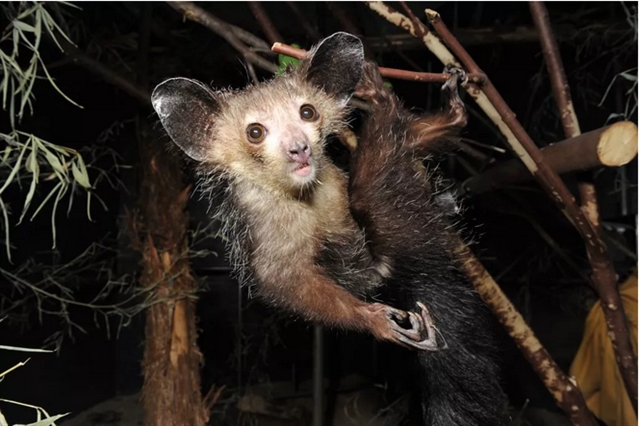论文标题:Fossil lemurs from Egypt and Kenya suggest an African origin for Madagascar’s aye-aye
期刊:Nature Communications
作者:Erik R. Seiffert et al
发表时间:2018/08/21
数字识别码:10.1038/s41467-018-05648-w
原文链接:https://www.nature.com/articles/s41467-018-05648-w?utm_source=Other_website&utm_medium=Website_links&utm_content=RenLi-MixedBrand-OAB-Multidisciplinary-China&utm_campaign=OAB_USG_JRCN_RL_article_promotion_sciencenet_Aug_5th
微信链接:https://mp.weixin.qq.com/s/nPXc1ueNa8Ku5tVhUn2twQ
《自然-通讯》近日发表的一项研究Fossil lemurs from Egypt and Kenya suggest an African origin for Madagascar’s aye-aye称,曾被广泛认为是一种果蝠的化石种Propotto leakeyi,其实是指猴型下目的一种狐猴,是马达加斯加指猴的近亲。在这项重新评估的基础上,系统发育分析结果显示,有两个狐猴支系独立地从非洲迁徙到了马达加斯加,这一结果挑战了当前公认的观点——狐猴进入马达加斯加的过程只发生了一次。

图1:马达加斯加指猴。David Haring
1967年,肯尼亚中新世早期(约2300万-1600万年前)沉积地层中发现的三个下颌断块被归入一种名为Propotto leakeyi的新灵长动物。不过,这种解释很快就受到了驳斥,有人指出Propotto leakeyi并不是灵长动物,而是一种果蝠——半个多世纪以来,后一种观点尚无人提出质疑。

图2:马达加斯加指猴。David Haring
美国南加州大学的Erik Seiffert和同事在分析评估了Propotto leakeyi的牙齿,以及埃及发现的距今约3400万年的灵长动物Plesiopithecus teras(一种近猿)的化石后发现:Propotto leakeyi不仅是灵长动物,还是Plesiopithecus teras和指猴的近亲。研究结果显示,狐猴型下目和指猴型下目的共同祖先拥有非洲血统,而且这两个狐猴支系曾沿不同路径横跨莫桑比克海峡,最终抵达马达加斯加。

图3:Propotto、Plesiopithecus和指猴的下颌臼齿形态比较,以及Plesiopithecus和Propotto放大的前牙。Gunnell et al.
作者指出他们的分析主要基于牙齿形态学,因此,只有在更新、更完整的化石发现后,才能对这些假说作进一步检验。
摘要:In 1967 G.G. Simpson described three partial mandibles from early Miocene deposits in Kenya that he interpreted as belonging to a new strepsirrhine primate, Propotto. This interpretation was quickly challenged, with the assertion that Propotto was not a primate, but rather a pteropodid fruit bat. The latter interpretation has not been questioned for almost half a century. Here we re-evaluate the affinities of Propotto, drawing upon diverse lines of evidence to establish that this strange mammal is a strepsirrhine primate as originally suggested by Simpson. Moreover, our phylogenetic analyses support the recognition of Propotto, together with late Eocene Plesiopithecus from Egypt, as African stem chiromyiform lemurs that are exclusively related to the extant aye-aye (Daubentonia) from Madagascar. Our results challenge the long-held view that all lemurs are descended from a single ancient colonization of Madagascar, and present an intriguing alternative scenario in which two lemur lineages dispersed from Africa to Madagascar independently, possibly during the later Cenozoic.
阅读论文全文请访问:https://www.nature.com/articles/s41467-018-05648-w?utm_source=Other_website&utm_medium=Website_links&utm_content=RenLi-MixedBrand-OAB-Multidisciplinary-China&utm_campaign=OAB_USG_JRCN_RL_article_promotion_sciencenet_Aug_5th
(来源:科学网)
特别声明:本文转载仅仅是出于传播信息的需要,并不意味着代表本网站观点或证实其内容的真实性;如其他媒体、网站或个人从本网站转载使用,须保留本网站注明的“来源”,并自负版权等法律责任;作者如果不希望被转载或者联系转载稿费等事宜,请与我们接洽。